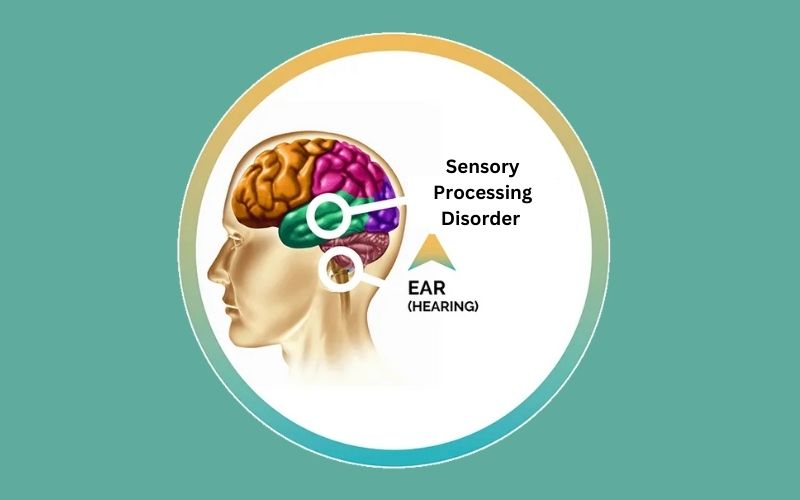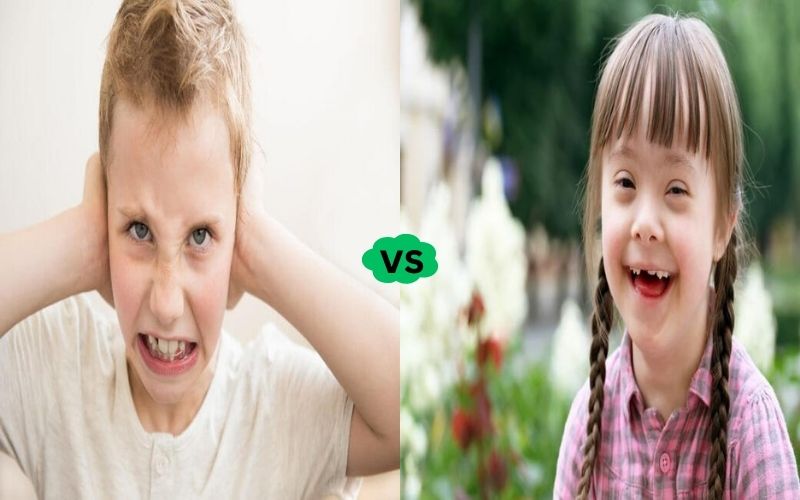Difference Between Sensory Processing Disorder and Autism
A Brief Overview of Sensory Processing Disorder and Autism
Sensory Processing Disorder and Autism are two neurological conditions that often coexist and share some common characteristics, leading to confusion and misunderstanding among the general public.
It is crucial to differentiate between these two conditions as they require distinct approaches to diagnosis, treatment, and support.
Sensory Processing Disorder (SPD) is primarily characterized by difficulties in processing and responding to sensory stimuli from the environment. Individuals with SPD may experience heightened sensitivities (hypersensitivity) or reduced sensitivities (hyposensitivity) to sensory input, such as touch, sound, taste, or smell.
These sensory challenges can significantly impact their daily lives, making seemingly ordinary experiences overwhelming.
Autism Spectrum Disorder (ASD), on the other hand, is a complex neurodevelopmental condition that encompasses a range of symptoms and behaviors. While sensory sensitivities are common in individuals with ASD.
It is just one aspect of a broader set of characteristics, including challenges in social interaction, communication difficulties, and repetitive behaviors.
Definition of Sensory Processing Disorder
Sensory Processing Disorder (SPD), also known as Sensory Integration Disorder, is a neurological condition characterized by atypical processing and response to sensory stimuli from the environment.
Individuals with SPD may experience difficulties in regulating and organizing sensory information, leading to a range of sensory sensitivities. These sensitivities can affect various sensory modalities, including touch, sound, sight, taste, smell, and the sense of body position (proprioception).

SPD can manifest in different ways. Some individuals may be hypersensitive, meaning they are overly reactive to sensory input and become easily overwhelmed by ordinary sensations, while others may be hypersensitive, showing reduced responsiveness to sensory stimuli and seeking intense sensory experiences.
As a result, individuals with SPD may exhibit behavioral, emotional, and functional challenges in daily life, impacting their ability to engage in age-appropriate activities and participate in social interactions.
It is essential to recognize and address SPD to provide appropriate support and intervention tailored to the individual’s sensory processing profile.
Definition of Autism
Autism, formally known as Autism Spectrum Disorder (ASD), is a complex neurodevelopmental condition characterized by a range of social, communicative, and behavioral challenges.
ASD encompasses a spectrum, meaning it can present in a wide variety of ways and with varying degrees of severity. Core features of autism include difficulties in social interaction, challenges in verbal and nonverbal communication, and repetitive behaviors or interests.

Individuals with autism often struggle with understanding and responding to social cues, making it challenging to form and maintain relationships. They may also have specific sensory sensitivities, as mentioned earlier, experiencing heightened or diminished responses to sensory input.
Individuals with autism may engage in repetitive behaviors or have intense, focused interests. The exact cause of autism is still under investigation, and it is considered a lifelong condition, although early intervention and tailored therapies can significantly improve outcomes.
Understanding the distinct characteristics of autism and how they differ from other conditions, such as Sensory Processing Disorder, is crucial for accurate diagnosis and appropriate support.
Characteristics of Sensory Processing Disorder and Autism
Sensory Processing Disorder (SPD):
Sensory Processing Disorder is characterized by atypical responses to sensory stimuli. Individuals with SPD may experience hypersensitivity, meaning they are overly reactive to sensory input, or hyposensitivity, where they exhibit reduced responsiveness to sensory stimuli.
These sensory challenges can manifest in various ways, affecting different sensory modalities:
- Tactile Sensitivity: Individuals with tactile sensitivity may be hypersensitive to touch, finding certain fabrics, tags on clothing, or even gentle touches uncomfortable or painful. Conversely, those with hyposensitivity may not register pain or temperature changes as acutely as others.
- Auditory Sensitivity: Auditory hypersensitivity can lead to an overreaction to sounds, making everyday noises, such as sirens, vacuum cleaners, or even background chatter, distressing. Conversely, auditory hyposensitivity may result in difficulty processing spoken language or a lack of response to important auditory cues.
- Visual Sensitivity: Hypersensitivity to light or visual stimuli may cause discomfort or distress in bright or visually stimulating environments. On the other hand, hyposensitivity may lead to a lack of responsiveness to visual cues.
- Oral Sensitivity: Some individuals may have heightened or diminished responses to taste, texture, or temperature of foods, impacting their dietary choices and eating behaviors.
- Vestibular and Proprioceptive Sensitivity: These senses, related to body movement and spatial awareness, can also be affected. Individuals may seek or avoid certain types of movements or activities.
- Emotional and Behavioral Impact: SPD can significantly affect an individual’s emotional and behavioral regulation. They may have meltdowns or withdrawal in response to sensory overload or discomfort.
Autism Spectrum Disorder (ASD):
Autism Spectrum Disorder is a neurodevelopmental condition characterized by a diverse range of features:
- Social and Communication Difficulties: Individuals with ASD may struggle with understanding and responding to social cues, leading to challenges in forming and maintaining relationships. Difficulties in verbal and nonverbal communication are common.
- Repetitive Behaviors and Interests: Repetitive behaviors, such as hand-flapping or insistence on sameness, are often observed. Individuals may also have intense, focused interests in specific topics.
- Sensory Sensitivities: Many individuals with ASD exhibit sensory sensitivities similar to those with SPD. They may be hypersensitive, hyposensitive, or show a combination of both, experiencing sensory stimuli differently from neurotypical individuals.
Causes of Sensory Processing Disorder and Autism
Sensory Processing Disorder (SPD):
The exact cause of SPD remains under investigation, but it is believed to result from a combination of genetic, environmental, and neurological factors.
Some potential contributors include:
- Genetics: There may be a genetic predisposition to sensory processing differences, as SPD often runs in families.
- Neurological Factors: Differences in brain structure and function, particularly in areas responsible for sensory processing, may play a role.
- Premature Birth or Trauma: Some cases of SPD may be associated with premature birth or early life trauma that affects sensory development.
- Environmental Factors: Exposure to certain environmental factors during critical periods of sensory development may contribute to SPD.
Autism Spectrum Disorder (ASD):
The causes of ASD are complex and not fully understood.
Research suggests a multifactorial origin involving genetic, environmental, and neurological factors:
- Genetics: There is strong evidence of a genetic component to ASD. Specific genes and genetic variations have been linked to increased susceptibility.
- Environmental Factors: Prenatal and early-life environmental factors, such as maternal infections, exposure to certain chemicals, or prenatal stress, may increase the risk of ASD.
- Neurological Factors: Abnormal brain development, particularly in regions associated with social communication and sensory processing, is a significant factor in ASD.
- Combined Influence: It is likely that ASD results from the interplay of genetic susceptibility and environmental factors.
Connectivity between Sensory Processing Disorders and Autism Spectrum Disorders
There is a notable overlap between sensory processing issues in SPD and ASD. Many individuals with ASD experience sensory sensitivities similar to those with SPD.
This connectivity is observed in the following ways:
- Shared Sensory Features: Hypersensitivity and hyposensitivity to sensory stimuli are common in both SPD and ASD. Individuals may exhibit sensory-seeking behaviors, avoidance of certain sensory inputs, or sensory-related distress.
- Impact on Behavior: Sensory challenges can significantly impact behavior in individuals with both conditions. This may include meltdowns, withdrawal, or coping mechanisms to deal with sensory overload or discomfort.
- Co-Occurrence: SPD and ASD frequently co-occur. Some individuals with ASD may meet the diagnostic criteria for SPD as well. Understanding these overlapping characteristics is crucial for providing comprehensive support and tailored interventions for individuals with both conditions.
Difference Between Sensory Processing Disorder and Autism
Here is a comparison chart highlighting the key differences and similarities between Sensory Processing Disorder (SPD) and Autism Spectrum Disorder (ASD):
| Aspect | Sensory Processing Disorder (SPD) | Autism Spectrum Disorder (ASD) |
|---|---|---|
| Definition | A neurological condition characterized by atypical responses to sensory stimuli, affecting sensory processing. | A complex neurodevelopmental disorder characterized by social and communication challenges, as well as repetitive behaviors. |
| Primary Characteristics | – Sensory sensitivities (hypersensitivity or hyposensitivity) to various sensory stimuli. Impact on daily life and emotional regulation. | – Social and communication difficulties. Repetitive behaviors and intense interests. Sensory sensitivities. |
| Diagnostic Criteria | Clinical evaluation and standardized assessments for sensory processing patterns. | Clinical evaluation, observation, and adherence to specific criteria outlined in DSM-5 or ICD-10/ICD-11. |
| Assessment Tools | Sensory Profile, Sensory Processing Measure, observation by healthcare professionals. | Autism Diagnostic Observation Schedule (ADOS), Modified Checklist for Autism in Toddlers (M-CHAT), observation by specialists. |
| Treatment | Occupational therapy with sensory-focused interventions. Sensory diets. Parent and caregiver education. | – Early intervention services. Behavioral therapies like Applied Behavioral Analysis (ABA). Sensory interventions. Individualized education plans (IEPs). |
| Medications | Generally not a primary treatment approach, but may be used for specific symptoms or co-occurring conditions. | May be prescribed for managing symptoms such as anxiety, hyperactivity, or aggression. |
| Overlap in Sensory Sensitivities | Both conditions can exhibit sensory sensitivities, including hypersensitivity, hyposensitivity, and sensory-seeking behaviors. | Individuals with ASD often experience sensory sensitivities similar to those with SPD. |
| Communication and Social Interaction | SPD primarily affects sensory processing but does not inherently impact social or communication skills. | Impaired social interaction and communication skills are core features of ASD. |
| Repetitive Behaviors | SPD does not typically involve repetitive behaviors as a primary characteristic. | Repetitive behaviors and intense interests are a hallmark of ASD. |
| Prevalence of Co-Occurrence | SPD can co-occur with other conditions, including ASD. | Sensory sensitivities are common in individuals with ASD, but not all individuals with ASD have SPD. |
| Genetic and Environmental Factors | The exact cause of SPD is not fully understood but is believed to involve genetics, neurology, and environmental factors. | ASD has a known genetic component and is influenced by environmental factors during prenatal and early development. |
| Long-Term Outlook | With appropriate interventions, many individuals with SPD can lead fulfilling lives with reduced sensory challenges. | Early intervention and tailored therapies can lead to improved outcomes, but ASD is generally a lifelong condition. |
Diagnosis and Assessment
Sensory Processing Disorder (SPD):
- Clinical Evaluation: Diagnosis of SPD typically begins with a comprehensive clinical evaluation by a trained healthcare professional, such as an occupational therapist. This evaluation involves gathering information from parents or caregivers about the individual’s sensory behaviors and challenges.
- Sensory Profile Assessment: Various assessment tools, such as the Sensory Profile or Sensory Processing Measure, may be used to gather quantitative data on sensory processing patterns. These tools help in identifying specific sensory sensitivities and determining the severity of the disorder.
- Observation: Observing the individual in various sensory situations can provide valuable insights into their sensory processing difficulties. Professionals may assess how the person responds to sensory stimuli and how these responses impact their daily life.
- Collaboration: Interdisciplinary collaboration may be necessary, involving occupational therapists, psychologists, and pediatricians, to rule out other possible conditions and provide a comprehensive assessment.
Autism Spectrum Disorder (ASD):
- Developmental Screening: ASD is often identified through developmental screening during well-child visits. Screening tools like the Modified Checklist for Autism in Toddlers (M-CHAT) help pediatricians assess a child’s social and communication development.
- Comprehensive Evaluation: A comprehensive evaluation is conducted by a team of specialists, including developmental pediatricians, child psychologists, speech and language therapists, and occupational therapists. This evaluation considers the child’s medical history, behavior, and communication abilities.
- Diagnostic Criteria: The diagnosis of ASD is based on specific criteria outlined in the Diagnostic and Statistical Manual of Mental Disorders (DSM-5) or the International Classification of Diseases (ICD-10/ICD-11). These criteria assess social communication impairments, repetitive behaviors, and sensory sensitivities.
- Observation and Assessment: Direct observation of the child’s behavior and interaction with others is a crucial component of the assessment process. Standardized tools like the Autism Diagnostic Observation Schedule (ADOS) may be used.
Treatment and Management
Sensory Processing Disorder (SPD):
- Occupational Therapy: Occupational therapists work with individuals with SPD to develop sensory strategies and interventions. Therapy may include sensory integration activities, desensitization exercises, and sensory diets tailored to the individual’s needs.
- Sensory-Focused Interventions: Sensory-based interventions, such as sensory rooms or sensory tools like weighted blankets or fidget toys, can help individuals regulate their sensory experiences.
- Parent and Caregiver Education: Educating parents and caregivers about SPD and strategies for managing sensory challenges at home and in daily life is essential.
Autism Spectrum Disorder (ASD):
- Early Intervention: Early intervention services, such as Applied Behavioral Analysis (ABA) and speech therapy, are critical for addressing social and communication deficits in children with ASD.
- Behavioral Therapies: ABA therapy is a widely used behavioral intervention that focuses on improving social skills, and communication, and reducing challenging behaviors.
- Sensory-Focused Interventions: Occupational therapy can be beneficial for individuals with ASD to address sensory sensitivities and motor skills difficulties.
- Medications: In some cases, medications may be prescribed to manage specific symptoms or co-occurring conditions, such as anxiety or hyperactivity.
- Individualized Education Plans (IEPs): School-aged children with ASD often have IEPs that outline educational goals and accommodations to support their learning needs.
Conclusion
Sensory Processing Disorder (SPD) and Autism Spectrum Disorder (ASD) are distinct neurodevelopmental conditions that share some overlapping characteristics, including sensory sensitivities.
Diagnosis and assessment for both disorders involve clinical evaluation, standardized assessments, and observation by healthcare professionals. Early intervention is crucial for improving outcomes in both cases.
For SPD, treatment primarily involves occupational therapy, sensory-focused interventions, and caregiver education. ASD management includes a multidisciplinary approach with early intervention, behavioral therapies, sensory interventions, and, in some cases, medication.

